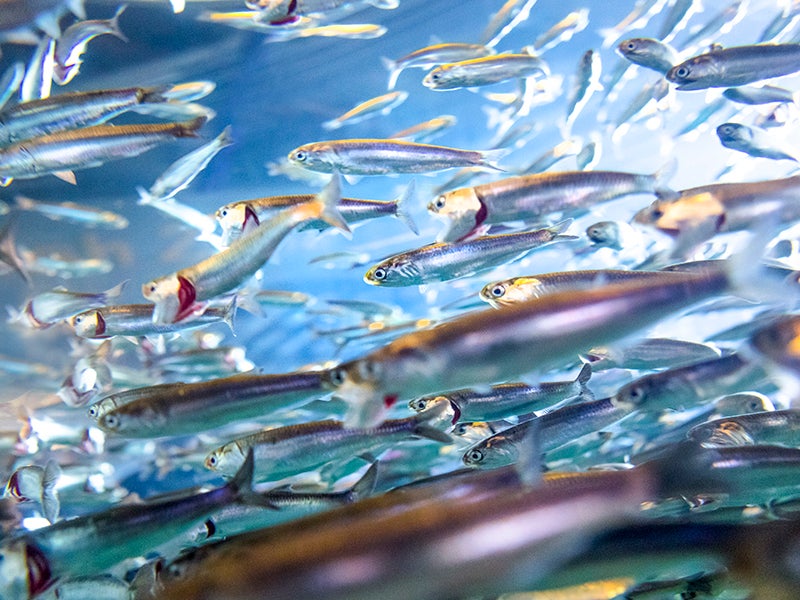Court Says Anchovy Catch Limit Relied on Fishy Data
A federal judge’s decision marks a promising turning point for the anchovy and the health of California’s ocean ecosystem.

This page was published 7 years ago. Find the latest on Earthjustice’s work.
Anchovies are little fish with a big impact. When they’re overfished, the whales, salmon, sea birds and other marine predators that rely on them as a dietary staple face starvation and death. But a recent court decision marks a promising turning point for the anchovy and the health of California’s ocean ecosystem.
In January, a federal judge ruled that the National Marine Fisheries Service violated the nation’s fishery management law by relying on decades-old data and failing to prevent overfishing of the northern anchovy off the California coast. In a follow-up ruling on June 13, the judge rejected the government’s request to limit this ruling and confirmed that the Fisheries Service must implement new limits based on the best available science to effectively protect our ocean ecosystem.
The health and biodiversity of marine animals depend on a vibrant and productive ocean food web. Northern anchovies are essential for marine ecosystems to thrive, as they are among the most important forage fish for ocean predators in California, including humpback whales, seals, sea lions, brown pelicans and other sea birds, tuna and Chinook salmon. The collapse of anchovy and other forage species, made worse by excessive fishing, is responsible for the deaths, mass strandings and reproductive failures of various species that have occurred in recent years.
When the Fisheries Service proposed its Catch Rule in October 2016, the best available science showed that the northern anchovy population was between 15,000 to 32,000 metric tons (mt). Studies showed that the population estimates for 2009 to 2011 were the lowest in 60 years, and there had been no substantial recovery of the species. At this time, anchovy-dependent predators like the California brown pelican and California sea lion had already experienced multi-year starvation and breeding failures due to lack of food.
However, the agency’s annual catch limit was based on data from 1964 to 1990 that estimated the anchovy population at more than 700,000 mt. The study used is widely acknowledged by scientists as outdated, incorrect, and certainly not indicative of the current population size. The annual catch limit allowed for wildly excessive fishing.
Continuing to allow excessive fishing of the northern anchovy while its population is so low decreases its chances of rebounding to a bountiful level, making threatened marine animals even more vulnerable to food shortages in coming years. Protection of these creatures requires immediate implementation of a very low catch limit that safeguards the anchovy population.
In November 2016, the international ocean conservation and advocacy organization Oceana, represented by Earthjustice, filed a lawsuit challenging the proposed 25,000 mt catch limit on the grounds that the Fisheries Service disregarded multiple scientific sources indicating that this catch level could exceed the entire anchovy population. The judge agreed: The January ruling found that the annual catch limit and other limits that are meant to prevent overfishing and ensure sustainable catch levels were not based on the best scientific information available and that the Fisheries Service did not demonstrate that its management prevented overfishing. The June 13 order batted down the agency’s request that the court leave two of these limits, known as the acceptable biological catch and overfishing limit, in place — even though the court had found them arbitrary, unlawful, and contrary to the best available science.
The agency must now develop measures that accurately reflect the current status of the anchovy population and ensure that enough of them stay in the ocean to feed the marine animals that depend on them.
“The law is clear: the agency can’t sweep inconvenient facts under the rug and rely on a bureaucratic preference to ‘set it and forget it’ for the most ecologically critical fish on the West Coast,” says Earthjustice attorney Andrea Treece.
This win is especially significant because the Fisheries Service has proposed to indefinitely freeze this outdated catch rule in an attempt to ensure that it would never be required to change the limits, regardless of current science. The victory strikes down the catch rule currently in place and requires the agency to use the best science to protect the food web of the diverse and wild California Current marine ecosystem. This will improve the health of our oceans and provide cultural, environmental, and economic benefits for generations to come.
Earthjustice’s Oceans Program uses the power of the law to safeguard imperiled marine life, reform fisheries management, stop the expansion of offshore oil and gas drilling, and increase the resiliency of ocean ecosystems to climate change.